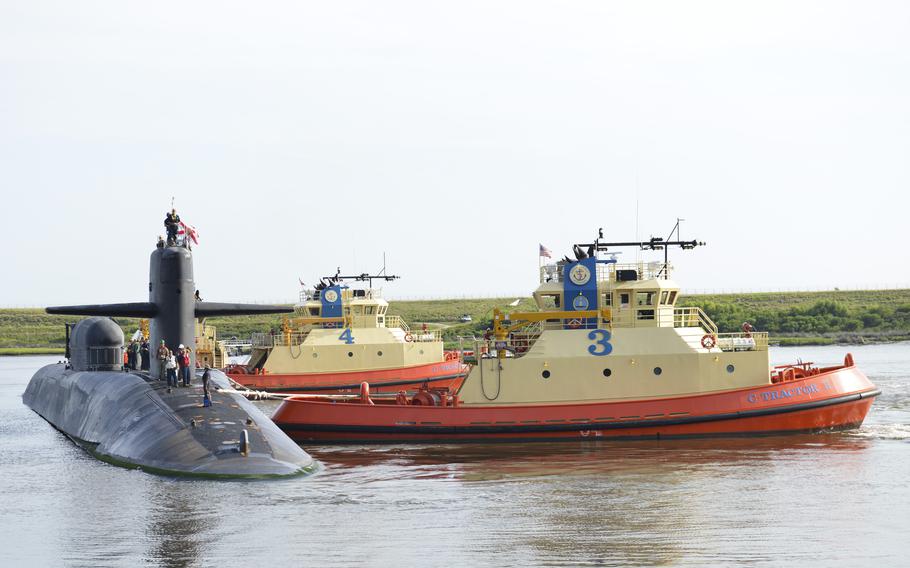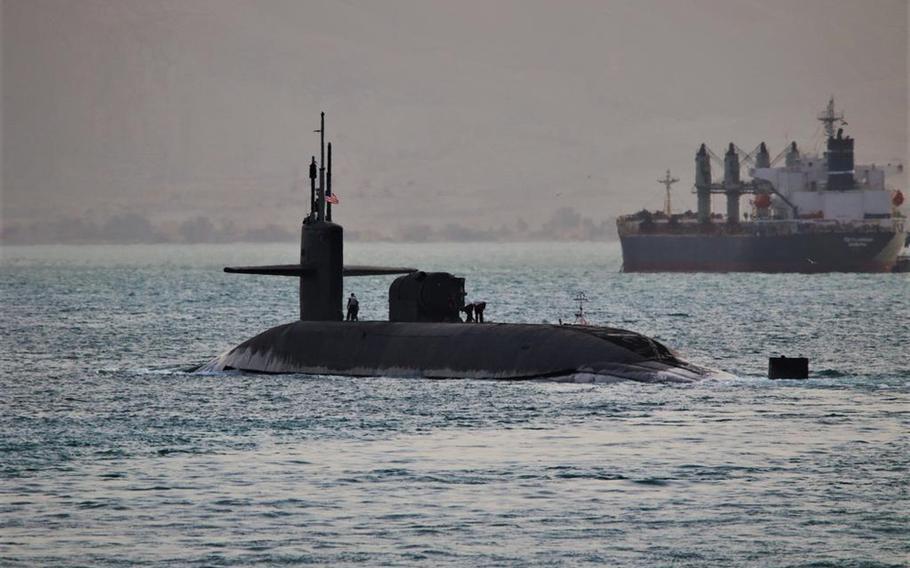
Sailors of the gold crew assigned to Ohio-class, guided-missile submarine USS Florida make preparations July 31, 2024, to moor after returning to the ship’s homeport at Naval Submarine Base Kings Bay, Ga., following a deployment to 5th and 7th Fleet areas of operations. (Travis S. Alston/U.S. Navy)
The USS Florida, an East Coast-based submarine, returned to the U.S. on Wednesday following a rare deployment in the Pacific.
“We operate undetected anywhere,” said Capt. Peter French, one of two commanding officers of the submarine. “The biggest takeaway from this is the versatility to go to multiple theaters of operation and be able to operate successfully.”
The submarine’s homecoming at Naval Submarine Base Kings Bay in Georgia culminated a more than 700-day deployment during which it circumnavigated the globe. An East Coast submarine operating in the Pacific, Navy leaders said, is unprecedented.
Aside from the Pacific, the warship operated in the Navy’s fifth and sixth fleets, which encompasses the waters of Europe, Africa and the Middle East, sailing more than 60,000 nautical miles.
The Florida is one of four Ohio-class, guided-missile submarines capable of carrying 154 precision Tomahawk missiles that have a range of 1,000 nautical miles. The Florida was manned by two teams — a blue crew and a gold crew — which alternated running the ship every five months, leaders said.
Two crews, consisting of 15 officers and 150 enlisted sailors, are used to keep the submarine staffed at all times. One crew, typically the blue, will sail the submarine into a region, and the other crew conducts maintenance on the ship while it is in port.
Navy leaders were unable to provide specific deployment details, only saying the crew operated or trained to the full breadth of the submarine’s mission set, including anti-submarine warfare, anti-surface warfare, and surveillance and reconnaissance.
“I can tell you from the operations we did out there, we developed lots of lessons learned and passed on several very long messages detailing all the things that we learned from what we did,” French said.
A spokesperson for Submarine Group 10, which oversees the Florida, said the submarine most recently supported the aircraft carrier USS Dwight D. Eisenhower during an extended deployment to the Middle East and transited to Guam for a scheduled reloading of Tomahawk missiles.
Submarine movements are typically closely guarded secrets, but the Pentagon on rare occasions has highlighted a submarine’s presence as a deterrent to enemies.

Guided-missile submarine USS Florida transits the Suez Canal en route to the Red Sea on April 7, 2023. (Elliot Schaudt/U.S. Navy)
In April 2023, the Navy announced the Florida’s arrival in the Middle East in a show of force as Iran-backed militant attacks on U.S. forces escalated.
Later that year, in September, the Florida became the first-ever guided missile submarine to visit Norway. Rear Adm. Stephen Mack, director of maritime operations for U.S. Naval Forces Europe-Africa, said the visit was a “visible demonstration of the strength of the U.S.-Norway partnership.”
Navy leaders said the submarine also worked with special forces to practice coordinated missions. The Florida is capable of hosting 66 special operations forces onboard and is equipped with a dry deck shelter, a removable cylindrical module meant to allow divers and SEALs and their vehicles to enter and exit the submarine while it is submerged.
U.S. Central Command, which oversees military operations in the Middle East, announced in November that an unnamed Ohio-class submarine had entered its area of responsibility alongside a photo that appeared to show the submarine in the Suez Canal. The announcement came less than one month after the deadly Oct. 7 surprise attack on Israel by Hamas militants, triggering a war in Gaza and regional tensions and hostilities.
Cmdr. George Thompson, the executive officer for the Florida’s blue crew, said the submarine was en route to relieve another crew when it was directed to deploy to the Middle East.
“The plan changed, and we just executed the new plan,” he said. “That is what we train for and that is what we prepare for.”